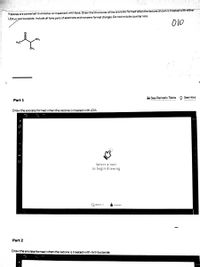
Chemistry
10th Edition
ISBN: 9781305957404
Author: Steven S. Zumdahl, Susan A. Zumdahl, Donald J. DeCoste
Publisher: Cengage Learning
expand_more
expand_more
format_list_bulleted
Question

Transcribed Image Text:Ketones are converted to enolates on treatment with base. Draw the structures of the enolates formed when the ketone shown is treated with either
LDA or tert-butaxide. Include all lone pairs of electrons and nonzero formal charges. Do not include counter ions.
010
H,C
i See Periodic Table o Se Hint
Part 1
Drawthe enolate formed when the ketone is treated with LDA:
Select a tool
to begin drawing
Mann 5
Part 2
Draw the enolate formed when the ketone is treated with tert-butoxide:
+ I : 0
Expert Solution
This question has been solved!
Explore an expertly crafted, step-by-step solution for a thorough understanding of key concepts.
Step by stepSolved in 2 steps with 2 images

Knowledge Booster
Learn more about
Need a deep-dive on the concept behind this application? Look no further. Learn more about this topic, chemistry and related others by exploring similar questions and additional content below.Similar questions
- When a single compound contains both a nucleophile and a leaving group, an intramolecular reaction occurs. With this in mind, what is the structure and stereochemistry of the following reaction?arrow_forwardDraw the structure(s) of the product(s) expected if 1-methylcyclohexanol were treated with concentrated hydroiodic acid.arrow_forwardH₂C OEt H₂C OEt 1. NaOEt, EtOH 2. H₂O* H₂C EtOH OEt Esters, like aldehydes and ketones, are weakly acidic. Treatment of an ester with 1 equivalent of a strong base, such as sodium ethoxide, causes a reversible carbonyl condensation to occur that forms a ẞ-ketoester. This reaction is known as the Claisen condensation. The tetrahedral intermediate thus formed expels an alkoxide leaving group to give an acyl substitution product, a ẞ-ketoester. The steps leading up to this point are all reversible. The best yields for the Claisen condensation are obtained when the starting ester has more than one acidic a-hydrogen. In these cases, a second deprotonation of the a-carbon drives the reaction equilibrium toward the product, thus requiring a full equivalent of base instead of a catalytic amount. Subsequent protonation with dilute aqueous acid resultsn a high yield of the final product. Draw curved arrows to show the movement of electrons in this step of the mechanism. Arrow-pushing…arrow_forward
- 2. There are two methods to convert an alkyl halide into a carboxylic acid containing one additional carbon atom: R-X R-X NaCN CH3CI Mg R-CN Br R-MgX H3O+ 1) CO₂ 2) H3O+ (CH3)3CCI i Depending on the structure of the alkyl halide, one or both of these methods may be used. For each alkyl halide shown, write out a stepwise mechanism that converts it to a carboxylic acid. If both methods work, draw both routes. If one method cannot be used, state why it cannot. HO R OH AiOH R OH Brarrow_forwardProtons on a carbon atom located adjacent to the carbonyl group generally absorb in the range of 1-2.5 ppm. Protons on a carbon atom located adjacent to an oxygen atom generally absorb in the range of 3.5-5 ppm. What is the structure of the ester from the Proton NMR spectrum?arrow_forwardWhat products will be obtained if the following compound is hydrolyzed completely in an aqueous solution of HCL?arrow_forward
arrow_back_ios
arrow_forward_ios
Recommended textbooks for you
 ChemistryChemistryISBN:9781305957404Author:Steven S. Zumdahl, Susan A. Zumdahl, Donald J. DeCostePublisher:Cengage Learning
ChemistryChemistryISBN:9781305957404Author:Steven S. Zumdahl, Susan A. Zumdahl, Donald J. DeCostePublisher:Cengage Learning ChemistryChemistryISBN:9781259911156Author:Raymond Chang Dr., Jason Overby ProfessorPublisher:McGraw-Hill Education
ChemistryChemistryISBN:9781259911156Author:Raymond Chang Dr., Jason Overby ProfessorPublisher:McGraw-Hill Education Principles of Instrumental AnalysisChemistryISBN:9781305577213Author:Douglas A. Skoog, F. James Holler, Stanley R. CrouchPublisher:Cengage Learning
Principles of Instrumental AnalysisChemistryISBN:9781305577213Author:Douglas A. Skoog, F. James Holler, Stanley R. CrouchPublisher:Cengage Learning Organic ChemistryChemistryISBN:9780078021558Author:Janice Gorzynski Smith Dr.Publisher:McGraw-Hill Education
Organic ChemistryChemistryISBN:9780078021558Author:Janice Gorzynski Smith Dr.Publisher:McGraw-Hill Education Chemistry: Principles and ReactionsChemistryISBN:9781305079373Author:William L. Masterton, Cecile N. HurleyPublisher:Cengage Learning
Chemistry: Principles and ReactionsChemistryISBN:9781305079373Author:William L. Masterton, Cecile N. HurleyPublisher:Cengage Learning Elementary Principles of Chemical Processes, Bind...ChemistryISBN:9781118431221Author:Richard M. Felder, Ronald W. Rousseau, Lisa G. BullardPublisher:WILEY
Elementary Principles of Chemical Processes, Bind...ChemistryISBN:9781118431221Author:Richard M. Felder, Ronald W. Rousseau, Lisa G. BullardPublisher:WILEY

Chemistry
Chemistry
ISBN:9781305957404
Author:Steven S. Zumdahl, Susan A. Zumdahl, Donald J. DeCoste
Publisher:Cengage Learning

Chemistry
Chemistry
ISBN:9781259911156
Author:Raymond Chang Dr., Jason Overby Professor
Publisher:McGraw-Hill Education

Principles of Instrumental Analysis
Chemistry
ISBN:9781305577213
Author:Douglas A. Skoog, F. James Holler, Stanley R. Crouch
Publisher:Cengage Learning

Organic Chemistry
Chemistry
ISBN:9780078021558
Author:Janice Gorzynski Smith Dr.
Publisher:McGraw-Hill Education

Chemistry: Principles and Reactions
Chemistry
ISBN:9781305079373
Author:William L. Masterton, Cecile N. Hurley
Publisher:Cengage Learning

Elementary Principles of Chemical Processes, Bind...
Chemistry
ISBN:9781118431221
Author:Richard M. Felder, Ronald W. Rousseau, Lisa G. Bullard
Publisher:WILEY